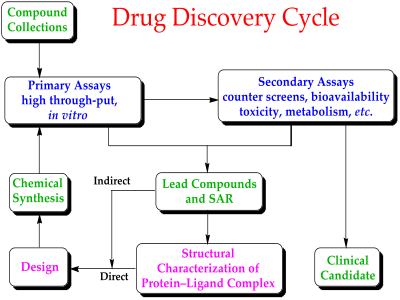Drug discovery facts for kids
|
|
Drug discovery is the exciting process where scientists find and create new medicines. These medicines help people and animals stay healthy, fight off diseases, and feel better. It's a bit like being a detective, but instead of solving a mystery, you're finding a way to fix a health problem!
In the past, many medicines were found by accident or by using old traditional remedies. For example, people noticed that certain plants could help with pain or sickness. Scientists would then try to find the active part of that plant.
Today, drug discovery is much more advanced. Scientists now try to understand exactly how diseases work inside our bodies, right down to the tiny molecules and body systems. This helps them design very specific medicines that target the problem directly.
The whole process of finding a new drug is long and involves many steps. It includes finding promising ideas, making new chemicals, testing them carefully, and making sure they are safe and work well for people.
Contents
What is Drug Discovery?
Drug discovery is the journey of finding and developing new drugs. These drugs are used to treat, cure, or prevent diseases. It's a very important field in medicine, biotechnology, and pharmacology.
How Drugs Were Found in the Past
For a long time, new medicines were often found by chance.
- Traditional Remedies: Many early medicines came from plants, herbs, or other natural sources that people had used for hundreds of years. Scientists would study these traditional remedies to find out which parts were actually helping.
- Accidental Discoveries: Sometimes, a new medicine was found completely by accident. A famous example is penicillin, the first antibiotic. It was discovered when a scientist noticed mold growing on a petri dish that was killing bacteria around it.
The Modern Way to Find Drugs
Today, drug discovery is a much more planned and scientific process. Scientists use their knowledge of how our bodies work and how diseases attack them. They look for specific targets, like a certain protein or a germ, that are causing the problem.
This modern approach involves many steps:
- Finding Candidates: Scientists look for molecules that might be able to affect a disease. This can involve studying thousands of different chemicals.
- Making New Chemicals: Once a promising molecule is found, chemists often create many similar versions of it. They try to make it work better and have fewer side effects.
- Testing and Screening: These new chemicals are then tested in labs. They use special tests called "assays" to see if the chemicals do what they are supposed to do, like kill bacteria or stop a harmful process in the body.
- Clinical Trials: If a drug looks promising in lab tests, it then goes through clinical trials. These are carefully controlled studies with people to make sure the drug is safe and effective. This step has several phases and can take many years.
- Formulation: Once a drug is approved, scientists figure out the best way to give it to people. This could be as a pill, a liquid, an injection, or a cream.
- Manufacturing: Finally, the drug is produced in large amounts so that it can be available to everyone who needs it.
This whole process is very complex and can take many years, sometimes more than 10 years, and cost a lot of money. But it's essential for bringing new and better treatments to people around the world.
See also
 In Spanish: Descubrimiento de fármacos para niños
In Spanish: Descubrimiento de fármacos para niños


